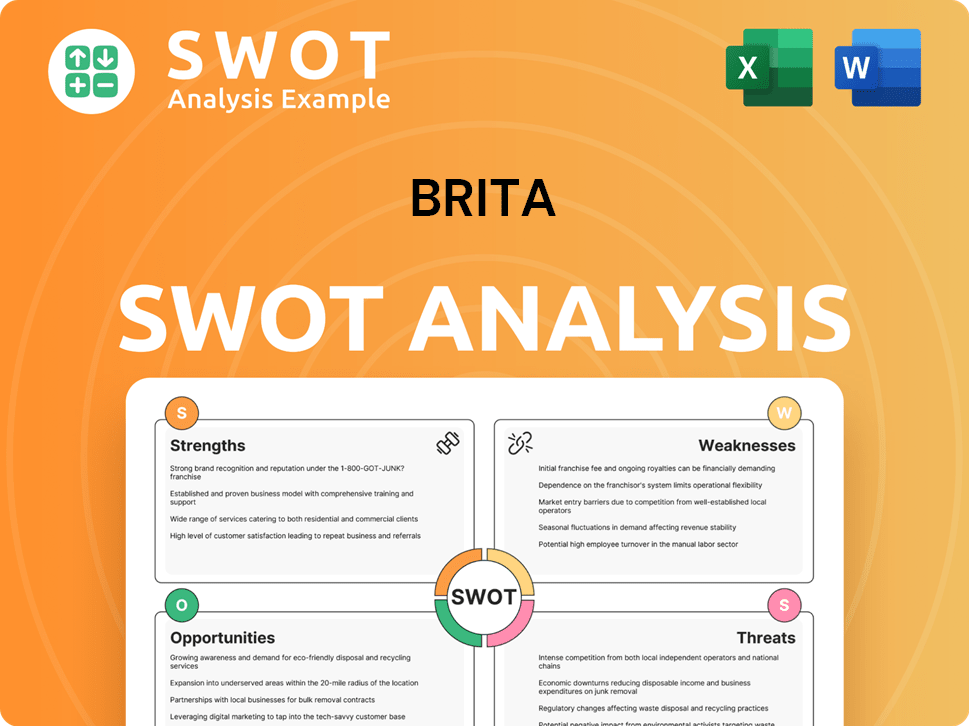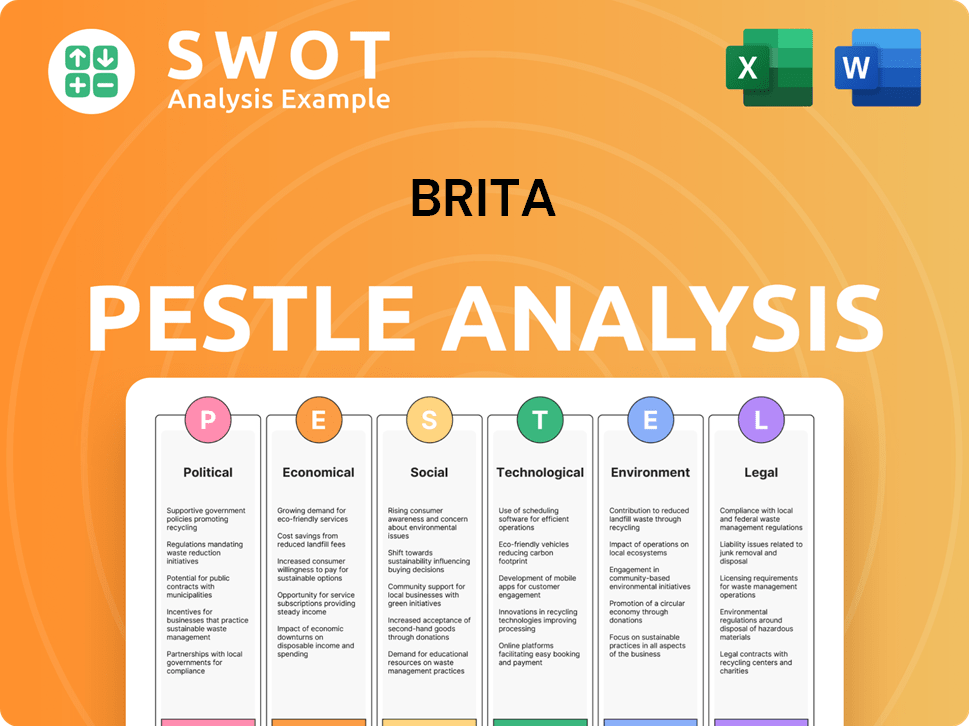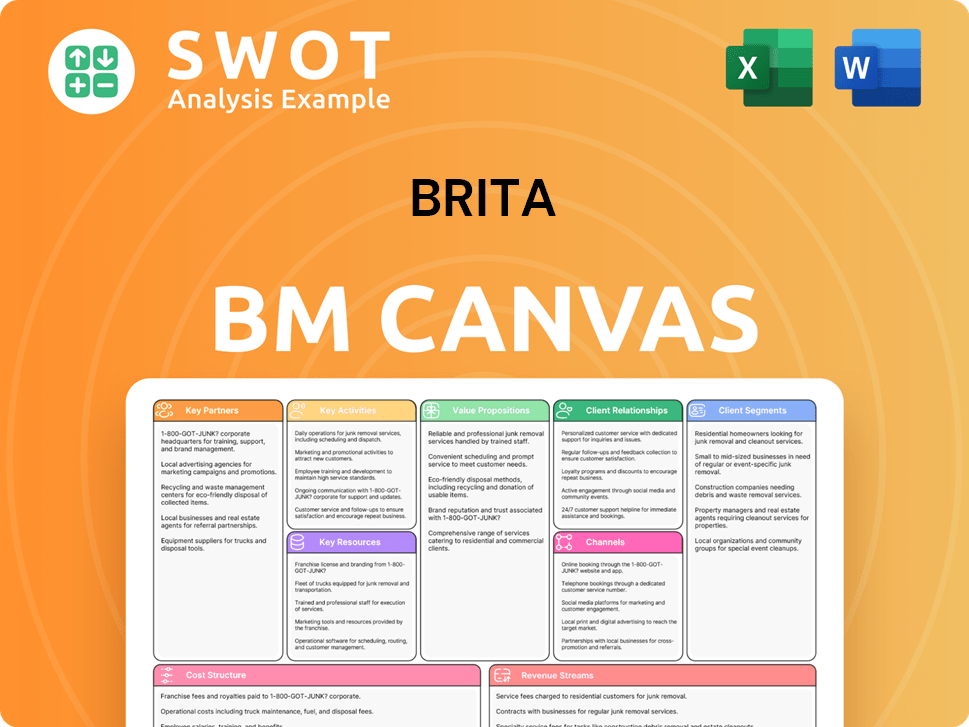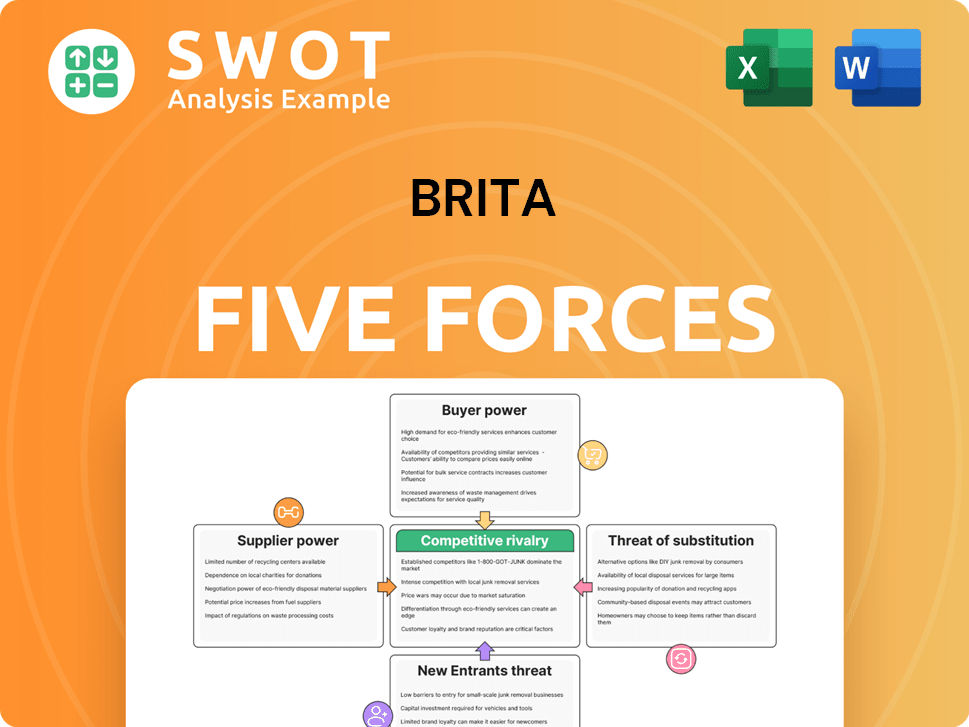Brita Bundle
How did a German company revolutionize how we drink water?
Brita, a name synonymous with clean water, started with a simple yet powerful idea. Founded in 1966 by Heinz Hankammer, this Brita SWOT Analysis reveals the journey of a company that transformed the water filtration industry. From humble beginnings in a garden, Brita has become a global leader, impacting millions with its innovative household products.

This brief history of Brita water filters explores the German company's evolution and its impact on the market. Understanding the Brita company timeline provides valuable insights into the history of water filtration technology and the company's commitment to innovation. Learn about the Brita water filter origin and how it has shaped the industry, from its manufacturing process to its environmental impact.
What is the Brita Founding Story?
The story of the Brita company began in 1966 in Taunusstein, Germany. It was founded by Heinz Hankammer, who initially named the company AquaDeMat. Hankammer's vision was to improve tap water quality, starting with car batteries and later expanding to household use.
An interesting aspect of the company's early days is that the first products were handcrafted under pear trees in Hankammer's garden. The entire Hankammer family played a role in the company's growth. This hands-on approach was key to establishing the brand.
In 1967, AquaDeMat, a filter designed to demineralize water for car batteries, entered serial production. This marked the debut of Brita's product line. The company was later renamed Brita, after Heinz Hankammer's daughter.
Heinz Hankammer established Brita GmbH in 1966 in Germany, initially focusing on water filtration for car batteries.
- The first filters were produced by hand.
- The company's name was derived from Heinz Hankammer's daughter's name.
- The initial product was designed to demineralize water for car batteries.
- Brita's early success set the stage for its expansion into household water filtration.
Brita SWOT Analysis
- Complete SWOT Breakdown
- Fully Customizable
- Editable in Excel & Word
- Professional Formatting
- Investor-Ready Format

What Drove the Early Growth of Brita?
The Brita company experienced significant growth and expansion following the launch of its first water filter jug in the early 1970s. This period marked a pivotal shift for the German company, as it began to establish itself in the market. The Brita water filter quickly became a household name, leading to further innovation and international ventures.
In the 1970s, the company introduced its initial product, the 'Haushaltswasserfilter I,' a simple water filter jug. The founder secured the first patent for domestic water filter use during this decade. This patent utilized ion exchange resin and active carbon to reduce impurities in water.
The 1980s saw the introduction of professional-grade filters, which gained popularity among businesses. The company expanded internationally, entering markets such as Spain, France, and Great Britain. This expansion was crucial for the growth of the Brita water filter and the company.
In 1988, a licensing and distribution agreement was established with The Clorox Company for North and South America. By 1999, the company held a 70% market share in the U.S. home water filtration market. Learn more about the Revenue Streams & Business Model of Brita.
By 2022, the company had a global workforce of 1,953 employees. Production sites are located in Germany, Great Britain, Italy, and China. The company has also expanded its presence in Asia, recognizing the potential of the water filtration market there.
Brita PESTLE Analysis
- Covers All 6 PESTLE Categories
- No Research Needed – Save Hours of Work
- Built by Experts, Trusted by Consultants
- Instant Download, Ready to Use
- 100% Editable, Fully Customizable

What are the key Milestones in Brita history?
The Brita company has achieved several significant milestones throughout its history, establishing itself as a leader in water filtration. The Brita water filter has become a household name, with a history marked by innovation and adaptation. This German company has consistently evolved to meet consumer needs and address environmental concerns.
| Year | Milestone |
|---|---|
| 1966 | Heinz Hankammer founded the company in Germany. |
| 1970 | The first water filter jug for home use was developed and patented. |
| 1999 | The company was acquired by The Clorox Company. |
| 2024 | Increased use of ISCC PLUS certified bio-based plastics announced. |
Brita water filter has consistently pushed the boundaries of water filtration technology. A key innovation was the 'tea test', which visually demonstrated the benefits of filtered water. The company has also secured numerous patents related to its water filtration technology, showcasing its commitment to innovation.
The development of the first water filter jug for home use, patented in 1970, was a groundbreaking innovation. This invention marked a significant advancement in making clean drinking water accessible to households.
Heinz Hankammer developed the 'tea test' to visually demonstrate the benefits of Brita water filter. This simple yet effective method showcased how Brita water filter prevented streaks in cooled tea compared to unfiltered water.
Brita company has increasingly focused on sustainability as a core innovation driver. The company aims to reduce virgin plastic in its signature portfolio by 30% by 2025.
Brita company has formed partnerships, such as with TerraCycle for recycling programs. This allows consumers to recycle used filters and contribute to a circular economy.
Brita company aims to eliminate 5,000 tons of packaging by 2025. All new packaging will be 100% recyclable from 2025 onwards, demonstrating a commitment to environmental responsibility.
Brita company has partnered with organizations like the Wildfowl and Wetlands Trust (WWT). Brita company is committed to donating £25,000 in 2024 and 2025 to WWT's Blue Recovery Fund.
Despite its successes, Brita company has faced challenges, including market share fluctuations in the late 1990s and early 2000s. The company's marketing strategies did not always resonate with consumers, leading to a need for strategic adjustments. To learn more about the competitive landscape, read about the Competitors Landscape of Brita.
In the late 1990s and early 2000s, Brita company experienced fluctuations in its market share. The company lost ground to competitors like PUR, which required strategic adjustments.
Between 1999 and 2006, Brita company struggled with marketing strategies that did not fully resonate with consumers. This led to the need for a brand reinvigoration strategy.
Brita company implemented a turnaround strategy focused on brand reinvigoration and product innovation. The company emphasized health benefits and environmental sustainability to regain market position.
Brita company enhanced its filter technology as part of its turnaround strategy. This included repositioning the brand as a lifestyle choice to meet evolving consumer needs.
Brita company has made sustainability a core part of its strategy. This includes increasing the use of bio-based plastics and aiming for net-zero emissions by 2050.
Brita company has formed key partnerships to support its environmental goals. Partnerships with TerraCycle and WWT demonstrate the company's commitment to sustainability.
Brita Business Model Canvas
- Complete 9-Block Business Model Canvas
- Effortlessly Communicate Your Business Strategy
- Investor-Ready BMC Format
- 100% Editable and Customizable
- Clear and Structured Layout

What is the Timeline of Key Events for Brita?
The Brita company has a rich history, marked by significant milestones in water filtration. Founded in 1966 by Heinz Hankammer, the German company quickly became a leader in household products, evolving from car battery filters to innovative water filter solutions. This chronological timeline highlights key events in the development of Brita water filters and the company's global expansion.
| Year | Key Event |
|---|---|
| 1966 | Heinz Hankammer founded Brita in Taunusstein, Germany, marking the beginning of the Brita water filter journey. |
| 1967 | The AquaDeMat, a demineralizing filter for car batteries, entered serial production. |
| 1970 | Brita launched and patented the first water filter jug for domestic use, revolutionizing household water filtration. |
| Early 1980s | Brita expanded internationally, entering markets in Spain, France, and Great Britain. |
| 1980 | Brita introduced professional-grade filters for the hospitality sector. |
| 1988 | The Clorox Company entered a licensing and distribution agreement with Brita for North and South America. |
| 1999 | Markus Hankammer became CEO of the Brita Group. |
| 2000 | Clorox acquired sole rights to the Brita brand in the Americas. |
| 2008 | Brita re-entered the North American market under the Mavea brand. |
| 2016 | Brita celebrated its 50th anniversary; the Mavea brand was withdrawn from North America, though Brita products remained. |
| 2024 | Brita acquired LARQ, expanding its product portfolio. |
| 2024 | Brita partnered with the LTA as the first non-single-use water brand to sponsor British tennis. |
| 2024-2025 | Brita committed £25,000 to WWT's Blue Recovery Fund for wetland restoration. |
Brita's 'Shaping Sustainable Solutions' strategy for 2025 underscores its commitment to environmental responsibility. The company aims to replace over 30 billion plastic bottles by 2025, preventing over 4.5 million tonnes of CO2. This initiative underscores the Brita water filter's role in promoting eco-friendly practices.
By 2025, Brita targets a 30% reduction in virgin plastics across its signature product portfolio. Furthermore, the company plans to eliminate virgin plastic in all new packaging from 2025. This commitment highlights Brita's dedication to minimizing its environmental footprint.
Brita continues to invest in product innovation, such as the PURITY C iQ filter, a data-driven, intelligent filtration system for coffee shops. The company is also expanding its use of ISCC PLUS certified bio-based plastics in its products, ensuring sustainable growth. These steps demonstrate Brita's dedication to the evolution of water filtration technology.
Brita's ongoing commitment to reducing single-use plastic and promoting sustainable water consumption aligns with its founding vision. This focus ensures the company remains a leader in the water filtration market. The company continues to evolve, addressing environmental issues and consumer needs.
Brita Porter's Five Forces Analysis
- Covers All 5 Competitive Forces in Detail
- Structured for Consultants, Students, and Founders
- 100% Editable in Microsoft Word & Excel
- Instant Digital Download – Use Immediately
- Compatible with Mac & PC – Fully Unlocked

Related Blogs
- What is Competitive Landscape of Brita Company?
- What is Growth Strategy and Future Prospects of Brita Company?
- How Does Brita Company Work?
- What is Sales and Marketing Strategy of Brita Company?
- What is Brief History of Brita Company?
- Who Owns Brita Company?
- What is Customer Demographics and Target Market of Brita Company?
Disclaimer
All information, articles, and product details provided on this website are for general informational and educational purposes only. We do not claim any ownership over, nor do we intend to infringe upon, any trademarks, copyrights, logos, brand names, or other intellectual property mentioned or depicted on this site. Such intellectual property remains the property of its respective owners, and any references here are made solely for identification or informational purposes, without implying any affiliation, endorsement, or partnership.
We make no representations or warranties, express or implied, regarding the accuracy, completeness, or suitability of any content or products presented. Nothing on this website should be construed as legal, tax, investment, financial, medical, or other professional advice. In addition, no part of this site—including articles or product references—constitutes a solicitation, recommendation, endorsement, advertisement, or offer to buy or sell any securities, franchises, or other financial instruments, particularly in jurisdictions where such activity would be unlawful.
All content is of a general nature and may not address the specific circumstances of any individual or entity. It is not a substitute for professional advice or services. Any actions you take based on the information provided here are strictly at your own risk. You accept full responsibility for any decisions or outcomes arising from your use of this website and agree to release us from any liability in connection with your use of, or reliance upon, the content or products found herein.